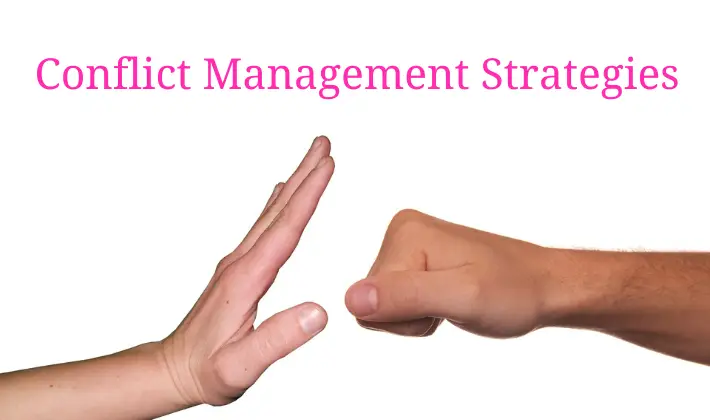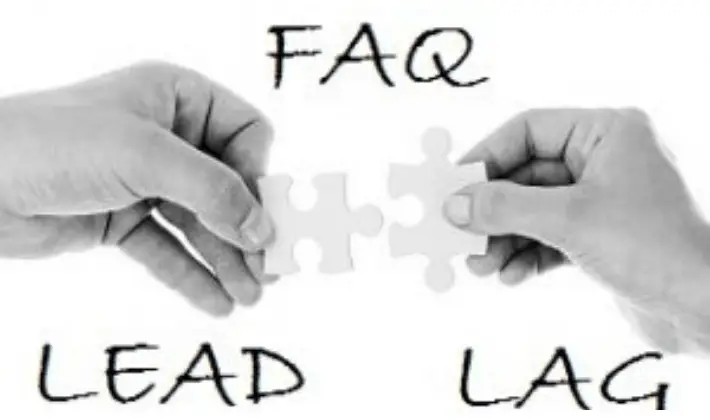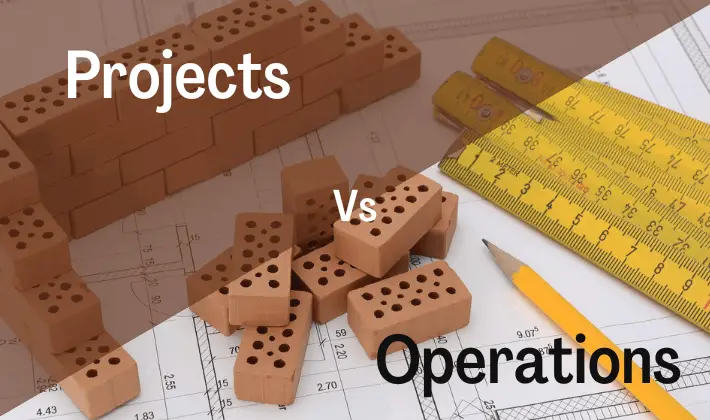Conflict resolution is an art of recognizing and handling disputes in a sensible, efficient, and balanced manner.
According to the PMBOK Guide (A Guide to Project Management Body of Knowledge) 7th edition, there are 6 conflict management strategies. These are:
- Confronting/Problem Solving
- Collaborating
- Compromising
- Smoothing/accommodating
- Forcing
- Withdrawal/avoiding
Let’s understand the overall conflict resolution process and discuss the above 6 strategies in a little bit more detail. Let us also find out which is the most effective strategy for successful conflict resolution.
Note: The 6th edition of PMBOK Guide had 5 conflict resolution strategies. It did not list ‘Confronting’ as a conflict resolution technique. If you are planning to take the PMP certification exam (Project Management Professional) in the near future, you should consider all six techniques including ‘Confronting’.
Why do Conflicts Happen?
Workplace conflict arise when two or more people have difference of opinion or different priorities.
Conflicts are part and parcel of every project. Conflicts happen in every group setting whether they are business or personal. People always find ways to disagree on one thing or the other.
There are many reasons for workplace conflict. The disputes can arise because of interpersonal conflict, personal working styles, and project priorities. Here are some of the main causes of disagreements that can lead to conflicts:
- Scarcity of resources
- Scheduling preferences
- Administrative procedures
- Technical options and solutions
- Budgetary allocations
- Project changes
- Personal differences
The conflicts must be proactively resolved otherwise they can cause:
- Low team morale
- Distrust among team members
- Reduction in team productivity
- Loss of authority of the project manager
- Poor quality outputs
How to Resolve Conflict?
Ground rules and common understanding among team members can prevent conflict. Project management techniques like effective communication, proper role definition, and periodic meetings can also reduce quantum and magnitude of disputes.
The disputes should be addressed immediately as soon as they arise. They should be dealt early and should not be allowed to fester. It is better to resolve the disputes in private by employing an open and collaborative approach.
The project manager along with the team members is responsible for resolving the conflicts and reaching a satisfactory solution. The project managers can employ conflict resolution skills including active listening, emotional awareness, problem solving, negotiation, and effective communication skill for managing conflict.
If a conflict gets out of hand and becomes disruptive, project managers can follow formal procedures, which could include disciplinary actions.
Project managers must keep the following points in mind while tackling the disputes:
- Disagreements are natural. No one should be blamed for them.
- Disputes can be fixed by exploring the alternatives.
- An unresolved conflict can become a serious problem.
- Openness can resolve conflict early.
- The resolution mechanism should be centered on the issues and not on individuals.
- The possible solution must focus on the present and not on the past.
6 Conflict Management Strategies in Project Management
Effective conflict management leads to positive working relationships, greater cohesion, and higher productivity. When differences of opinion are managed well, they can lead to creative solutions and improved decision making.
A conflict management strategy is a way to resolve dispute. There are six formal strategies to sort out the disputes. Anyone of these methods can be employed to resolve the issue at hand. The project managers must learn the nuances of these to methods resolve interpersonal conflict.
1. Confronting/Problem Solving
This technique resolves conflicts by having an open discussion about the disagreements. The disagreeing parties treat the conflict as a problem that needs to be solved. They find and eliminate the root cause of the conflict in order to resolve it completely. They collectively bring about a solution that is acceptable to everyone.
This method works only when there is openness, good relationship, and mutual trust among the involved parties.
The major downside of this technique is that it usually takes longer to arrive at a solution than the other methods. However, the major advantage is that everyone agrees to the final solution and it fixes the root cause of the problem.
It is also called as win-win strategy.
2. Collaborating
This technique resolves conflicts by looking at the conflict from different perspectives and incorporating multiple viewpoints. It requires an open dialogue and collaborative attitude.
Collaboration doesn’t work if the views of the disagreeing parties are not harmonious with each other. It provides a great platform to learn from each other.
3. Compromising/Reconciling
This technique resolves conflicts by finding a middle ground that is acceptable to conflicting parties. It involves bargaining and tradeoffs by accepting something in exchange for something else.
E.g. if two people are disagreeing on two different points, they resolve the conflict by accepting the viewpoint of the other person on one point each.
The main drawback of this approach is that sometimes essential aspects of the project are sacrificed to meet individual goals.
This approach brings in some degree of satisfaction to all the parties involved. It, usually, brings a temporary or partial solution because all disputing parties give away something. That is why, it is also called as a lose-lose strategy.
4. Smoothing/Accommodating
This technique resolves conflicts by emphasizing on areas of agreement and not discussing about the disagreements.
Smoothing is an effective way of maintaining harmony and preventing outwardly conflicting situations. it is a way to make people comfortable.
E.g. if two people have an agreement on three points but a disagreement on one point they they move forward by ignoring the point of disagreement. They might not even discuss the point of disagreement and just say that it is a trivial and minor point in the larger scheme of things.
The major downside of this technique is that it is a delay strategy – it only brings in a temporary solution as the point of disagreement was never really discussed. It maintains peace in the short term but can lead to more intense and acrid problems in the future.
5. Forcing/Directing
This technique resolves conflicts by using one’s positional power to force a viewpoint. Usually, there is little or no discussion and one person imposes his viewpoint on the other to settle the issue.
This technique can be employed when you are in hurry and have to deal with an emergency. It can be also used when there is no base for negotiation or when when the disputing parties are not cooperative and resolute.
This is a perfect strategy when project managers need to make quick decisions on unpopular issues like budget cuts. schedule compression, resource reduction etc.
Forcing is usually less time-consuming than other techniques but it creates disenchantment among staff members. It is also called as win-lose strategy since one person wins and other person loses in the conflict when this strategy is employed.
6. Withdrawal/avoiding
This technique resolves conflicts by withdrawing oneself from actual or potential conflict situation. It is a way of avoiding the conflict. In this, one of the disagreeing persons refrains from taking a position and yields to the other person’s point of view.
This method allows time to cool off and take stock of the situation It is a good approach when one of the conflicting parties is non-cooperative and unresponsive.
This strategy gives a temporary solution as it doesn’t really solve any problem – it only postpones the problem. It can also weaken your standing and authority in the project.
Summary
| Technique | When to use? | Advantages | Disadvantages |
|---|---|---|---|
| Confronting |
|
|
|
| Collaborating |
|
|
|
| Compromising |
|
|
|
| Smoothing |
|
|
|
| Forcing |
|
|
|
| Withdrawal |
|
|
|
Conflict Resolution Techniques and PMP Exam
We already know that between 6th edition and 7th edition, PMI (Project Management Institute) introduced a new method to resolve conflicts.
It would seem that the field of project management is progressing in the right direction. PMI (Project Management Institute) is doing some research and adding new knowledge to the project management knowledge-base as it becomes known.
However, this is not true.
The fact is that PMI had listed six strategies to resolve conflicts in PMBOK Guide 4th edition but they dropped one when the fifth edition was published. The 6th edition continued with what was described in the 5th edition.
PMI didn’t drop one strategy. Rather, it merged two strategies “confrontation” and “compromise” together. To me, this doesn’t seem right as, we will find later in the article that, these strategies have two completely different meanings.
So, how many techniques are actually there? Should we follow 7th edition or 6th edition?
I believe PMI listed five strategies in previous editions because the conflict model defined by Ken Thomas and Ralph Kilmann had defined five techniques.However, I think, the conflict model with six techniques is a better model.
Which is the Most Effective Conflict Resolution Strategy?
There is no single method that can be considered as most effective or potent. Different techniques are useful at different junctures. In fact, what may work today with person X may not work again tomorrow with the same person.
The project managers should analyze the situation and figure out what action is best suited for the correct situation. Here are some of the things that they should consider while employing a conflict management strategy:
- Degree and intensity of the discord.
- Emotional intelligence of the people involved.
- Interpersonal relationships.
- Importance of conflict.
- Time pressure to resolve the dispute.
- Maintenance of good relation between disagreeing parties.
Over to you
What is your take on the conflict management strategy? Do you think confrontation should be treated as the sixth strategy?
Which technique do you regularly employ at your workplace to resolve task conflict?







